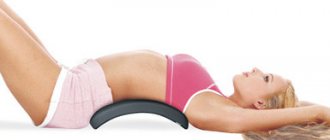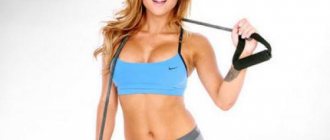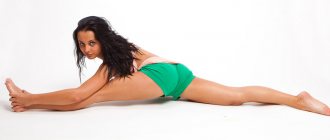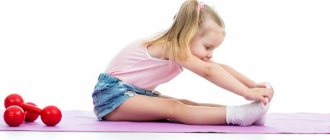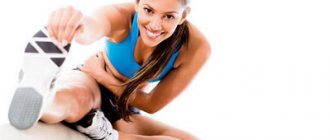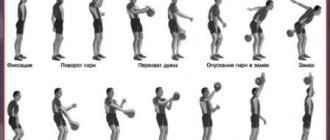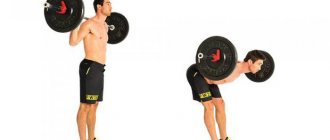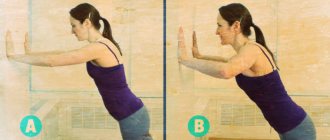— Learning to do a bridge on your own Advantages: we do the exercise ourselves, it’s good for health
Disadvantages: no
Is it possible to learn to do an exercise such as a bridge on your own, without the help of an instructor? Of course you can, but you should not immediately start doing this particular exercise - it may be difficult for beginners to perform a bridge without preparation, since this exercise requires good flexibility of the back and shoulder joints.
So, in order to learn how to do a bridge on your own, let's start doing those exercises that will prepare your back and shoulder joints for stress, help the body learn to be flexible and dexterous, and fight fatigue.
What do we need for this?
- comfortable clothes
exercise mat
ventilated room
good mood
After you have collected everything you need, you can begin to prepare - to perform those exercises that will be possible for even a beginner to perform.
Exercise "Snake"
This exercise is aimed at developing back flexibility - it will help the back muscles slowly and gradually get used to the load, begin to bend and become soft and obedient.
Starting position: lie on the floor on your stomach, face down, arms near your chest, palms resting on the floor, elbows bent.
Slowly we begin to rest our palms on the floor and lift our chest off the floor. Attention! The hips must fit snugly to the floor and cannot be lifted off the floor!
Do not try to immediately perform the exercise with maximum deflection; remember that high-quality and correct results are achieved only gradually, performing the exercise consistently and correctly.
When you reach the maximum point of the bend, slowly bend back while maintaining even breathing.
Repeat the exercise at least 8 times in the initial stages of training, then, gradually, you can increase the repetition of the exercise up to 32 times.
Exercise "Box"
After completing the “Snake” exercise, we proceed to the second exercise - “Box”.
It will be somewhat more difficult to perform, but it is necessary in order to learn how to do the “Bridge”.
So, the starting position: the same as in the “Snake” position.
The first part of the “Box” is the “Snake”, only when your body reaches the maximum point of deflection - bend your knees and pull your toes as close to your head as possible.
Don't be upset if you don't succeed the first time - the exercise is quite difficult for unprepared beginners. But after 4-5 workouts you will notice improvements in performing this exercise.
Important! Do not do the exercise abruptly, so as not to injure the vertebrae and muscle corset. Perform the exercise calmly and slowly so that the body is ready for qualitative changes.
Exercise "Bridge"
After you are able to complete 2 preparatory exercises, proceed to the main exercise “Bridge”.
You should not rush to complete it if you are unable to complete the “Snake” and “Box”. If so, continue doing these preparatory exercises every day until you get the hang of them.
So, proceeds to perform the “Bridge” exercise:
- lie down on your back
bend your knees and place your feet on the floor
bend your elbows, place your hands near your ears and rest on the floor
slowly raise the pelvis upward, resting your feet and hands on the floor
the head should be in a calmly lowered state
If you feel a little pain, this is normal, but there should not be sharp or severe pain. If you have such sensations, stop doing the exercise.
Stand at the maximum point of this exercise for a while, then lower your pelvis to the floor.
So we learned how to perform the “Bridge” exercise.
Before use, be sure to consult a specialist
Video review
| All(5) |
| How to make a bridge - a set of exercises | 12 Fat Burning Stretching Exercises You Can Do At Home | Yoga asanas - bridge pose: how to learn to do a bridge from a lying positionYoga for the spineYogalife | How to learn to do a backflip. Gymnastics. Gymnastics | How to get into the bridge correctly. Nuances and most common mistakes |
Speer attributes his success in the gym to years of gymnastics training. She helped him focus on more than just building muscle and strength. He targeted a mixture of endurance, stability, balance, power and muscular strength. And he became the athlete he is today. (We're pretty sure he got his six-pack the same way.) Take a cue from him and incorporate these eight gymnastics exercises into your workout routine today.
Boat and swing
These basic exercises work gymnasts' abs and teach them to tense all their muscles at once, which Speer says is absolutely necessary in the sport. Here's why this is important for you: the more firmly and steadily you can hold your position, the better you will be able to transfer force from your upper body to your lower body without wasting energy. This means you can more effectively perform squats, throws, pushes, lifts, jumps, punches, kicks, and running.
How to do it:
- Lie on your back, straight legs together, hands behind your head.
- Tighten your abs, lift your legs, head and shoulders five centimeters off the floor.
- Freeze. Your body should take the shape of a banana, from your fingers to your toes. This is a boat.
- Hold the position for at least 30 seconds and then start swinging to increase the intensity. This is a swing. Your abs will get another workout, Speer promises.
Bent body pull-up
As Speer says, this is the only way gymnasts do pull-ups. And they advise everyone else. Because in a bent position, the stability of the entire body increases, which allows you to concentrate more effort on lifting the body to the horizontal bar. It also engages more muscles, including the glutes and biceps, and works the lats and abs together.
How to do it:
- Grab the horizontal bar with an overhand grip, hands hip- or shoulder-width apart. Hang.
- Tighten your abs, squeeze your hips, and point your legs slightly forward so that your body forms a stretched C-shape.
- Maintain this bend throughout the entire exercise.
- As you pull yourself up, imagine that you are pressing on the top surface of the bar and focus on pulling your belly button up.
- Look straight ahead and touch the bar with your upper chest.
- Get down.
Angle squat
Gymnasts perform this exercise on parallel bars or rings. “This isometric exercise builds strength and endurance in your abs, hip flexors, lats and triceps,” says Speer. If you can hold for 20-30 seconds, your core is really strong.
How to do it:
- Sit between the paralets or, if there are none, between two hexagonal dumbbells.
- Grab the handles, tense your arms, lower your shoulders down, bend your knees and lift them and your butt off the floor. Hold for 30 seconds. Return to the starting position. When you can easily hold for 30 seconds with bent legs, try doing the same with straight legs.
Planche push-ups
Gymnasts perform the planche exercise to demonstrate their remarkable upper body strength and endurance. But this is aerobatics, so Speer recommends planche push-ups, that is, shifting the weight forward as you approach the floor. This will help to better develop the pectoral and deltoid muscles, as well as the core, muscles and connective tissues in the wrists and shoulders.
How to do it:
- Get into a push-up position, arms straight, palms at shoulder level, body straight.
- As you bend your elbows, allow your chest and shoulders to move forward until your palms are level with your chest or ribs.
- Hold, then return to the starting position.
Forward somersault
“Turls are the basis of acrobatics in gymnastics,” says Speer. “They improve spatial thinking and body control.” Yes, you are unlikely to do a backflip, but you should master the somersault well. “This is the easiest and most effective way to avoid injury from a fall.”
How to do it:
- Do this exercise on a mat, grass, or soft surface.
- Sit down, place your hands on the floor 3 cm from you, slightly wider than your shoulders.
- Bend your head between your hands, push your feet off the floor so that your hips go over your head.
- When your feet are up, push off with your hands and use the moment to get back to your feet.
Leg-split
Every gymnast should be able to do the splits. “But it takes time to learn,” Speer says. “We need sustained effort, not tension.” Well, why do you need this? To strengthen the flexibility of your biceps, hip flexors and your overall form, as Speer says. For most men, these muscles are always toned due to constant sitting. And the more elastic they are, the better you will be at performing almost any lower body exercise.
How to do it:
- It is important not to force yourself, not to go beyond comfortable sensations. If you feel pain, stop immediately.
- From a standing position, take a step forward and lower yourself down until the knee of your back leg touches the floor.
- Keep your torso straight, slowly straighten your front leg and move your foot forward as far as possible.
- Gently push your hips towards the floor.
- To make it easier, you can rest your hands on small boxes, benches or yoga blocks.
Front and back balance
These exercises improve balance, leg strength, flexibility of the biceps femoris and hips in general.
How to do it:
- For the front, place your feet shoulder-width apart, spread your arms to the sides, lift one leg as high as possible forward.
- Squeeze your quads and tighten your core.
- Don't move your hips; they should remain level throughout the entire exercise.
- For the back, instead of lifting your leg forward, lean forward so that your torso is parallel to the floor, and then lift one leg back so that it forms one line with your torso.
Handstand
It's to gymnastics what free throws are to basketball: an absolutely essential skill that takes a lot of time to perfect. But for you, this time will not be wasted: you will be able to strengthen your balance, core, flexibility, proprioception, shoulder and shoulder blade stability.
How to do it:
- Place your hands on the floor 15–30 cm from the wall, spread your fingers as wide as possible.
- Push your legs one at a time to get into a handstand against the wall and hold for as long as possible.
- If you can hold on for 30 seconds, try doing a stand that isn't against a wall.
- The main thing is to do it in a free place with a soft surface, so that if something happens, you can do a somersault.
Plan - summary of a lesson on jumping on the AKD
in the initial training group of 1 year of study
“Working out the technique of performing exercises to develop flexibility”
The date of the:
15.03. 2011
Location:
Purovskaya district sports school
Purpose of the lesson:
improvement and complication of exercises that develop flexibility and stretching. Application of flexibility and stretching exercises.
Method
: frontal, group, individual.
Exercise box how to do. Guidelines for sports instructors
I'm going abroad
Number of players – from 6 people or more.
The presenter acts as a customs officer. The players’ task is to “smuggle” some item abroad. And the essence of the game is that the player passes customs if he says a word starting with the first letter of his name. Players must guess what the customs officer's decision criteria are. Example: the first participant, Olga, says: “I’m going abroad and taking a swimsuit with me.” The customs officer replies: “I’m not letting you through,” then the next player tries to go through customs, and so on in a circle. Players name items until the customs officer gives the go-ahead, i.e. won’t say “I’m letting you in!” A variant of this game: the host comes up with any rule according to which he will “let” players through: either objects must begin with the player’s last name, or they must be of a certain color (for example, red), or they must be: fruits, hygiene items, outerwear, etc.
I take it with me on a hike...
Number of players – from 6 people or more. The presenter announces that he is going on a hike and would like to take those present with him. They can name any items that they think might be useful to them on the hike. The presenter must decide whether he takes this person with him or not. When moving from one player to another, it is necessary to transfer an object, for example, a match or a lighter. The host starts the game and says: “I’m going on a hike and taking a tent with me.” Then he passes the match (lighter) to the next player with the words: “Sergey, please take it” - this phrase
and is key, because a mandatory condition of the game is to address your neighbor by name and, when passing an object, say the word “please,” and the choice of object has absolutely no meaning. The players are not aware of this condition, since the presenter, naturally, does not report this. The players must guess for themselves what criteria the selection is based on. If Sergey says: “I’m taking a knife with me on a hike” and simply passes the match (lighter) to the next person, the leader replies: “Sergey, I’m not taking you on a hike with me.” And so on in a circle. Gradually the players figure out what needs to be done. The fun continues until the slowest player remains. Before the game starts, the host asks those who know this game or have guessed it not to reveal its essence.
Many people have various health problems (back pain, joint pain, digestive problems, headaches, etc., etc.) for one simple reason. They don't move much. The thing seems banal. But who does not neglect the simple and ingenious?
In this short note, I want to talk about one old-fashioned way to tone the body and strengthen muscles. It’s called a “box of matches.”
If you feel that lack of exercise is simply killing you, then make it a habit to scatter a box of matches around the house every day. Just take these matches and scatter them all over the house! And then, to restore order, start collecting them one by one. Don't leave this mess.
Preparatory exercises
After you have collected everything you need, you can begin to prepare - to perform those exercises that will be possible for even a beginner to perform.
Exercise "Snake"
This exercise is aimed at developing back flexibility - it will help the back muscles slowly and gradually get used to the load, begin to bend and become soft and obedient.
Starting position: lie on the floor on your stomach, face down, arms near your chest, palms resting on the floor, elbows bent.
Slowly we begin to rest our palms on the floor and lift our chest off the floor. Attention! The hips must fit snugly to the floor and cannot be lifted off the floor!
Do not try to immediately perform the exercise with maximum deflection; remember that high-quality and correct results are achieved only gradually, performing the exercise consistently and correctly.
When you reach the maximum point of the bend, slowly bend back while maintaining even breathing.
Repeat the exercise at least 8 times in the initial stages of training, then, gradually, you can increase the repetition of the exercise up to 32 times.
How to do the exercise
When performing this, without exaggeration, exercise, follow simple rules.
- There must be at least 50 matches.
- When lifting each match, squat rather than bend over, rounding your back. And if you are bending over, your back should be straight!
- Taking the match in your hand, stand up (or straighten up) and put it in the box lying on the table. Then come back for the next one. And so on until you have collected all the matches.
- Collect matches alternately with one hand or the other. This develops fine motor skills and coordination well.
This seemingly funny and even stupid at first glance exercise “brought back to life” more than one hundred backs and knees of people I know. And if you do it with humor and jokes, then a great mood is guaranteed for the whole day. You can turn it into a fun competition “who is faster...”.
By the way, this exercise also has a great side effect. You may be surprised to find that your excess weight has dropped.
The “box of matches” exercise can perfectly replace a cool set of morning exercises. Checked! Tone and increased breathing - what else is needed for health?
Play this game with children sitting in front of the computer or TV. They'll love it!
I am sure that after a month of daily gatherings, you will notice a significant improvement in your well-being and a decrease in body weight. Be healthy!
Speer attributes his success in the gym to years of gymnastics training. She helped him focus on more than just building muscle and strength. He targeted a mixture of endurance, stability, balance, power and muscular strength. And he became the athlete he is today. (We're pretty sure he got his six-pack the same way.) Take a cue from him and incorporate these eight gymnastics exercises into your workout routine today.
Boat and swing
These basic exercises work gymnasts' abs and teach them to tense all their muscles at once, which Speer says is absolutely necessary in the sport. Here's why this is important for you: the more firmly and steadily you can hold your position, the better you will be able to transfer force from your upper body to your lower body without wasting energy. This means you can more effectively perform squats, throws, pushes, lifts, jumps, punches, kicks, and running.
- Lie on your back, straight legs together, hands behind your head.
- Tighten your abs, lift your legs, head and shoulders five centimeters off the floor.
- Freeze. Your body should take the shape of a banana, from your fingers to your toes. This is a boat.
- Hold the position for at least 30 seconds and then start swinging to increase the intensity. This is a swing. Your abs will get another workout, Speer promises.
Bent body pull-up
As Speer says, this is the only way gymnasts do pull-ups. And they advise everyone else. Because in a bent position, the stability of the entire body increases, which allows you to concentrate more effort on lifting the body to the horizontal bar. It also engages more muscles, including the glutes and biceps, and works the lats and abs together.
- Grab the horizontal bar with an overhand grip, hands hip- or shoulder-width apart. Hang.
- Tighten your abs, squeeze your hips, and point your legs slightly forward so that your body forms a stretched C-shape.
- Maintain this bend throughout the entire exercise.
- As you pull yourself up, imagine that you are pressing on the top surface of the bar and focus on pulling your belly button up.
- Look straight ahead and touch the bar with your upper chest.
- Get down.
Angle squat
Gymnasts perform this exercise on parallel bars or rings. “This isometric exercise builds strength and endurance in your abs, hip flexors, lats and triceps,” says Speer. If you can hold for 20-30 seconds, your core is really strong.
- Sit between the paralets or, if there are none, between two hexagonal dumbbells.
- Grab the handles, tense your arms, lower your shoulders down, bend your knees and lift them and your butt off the floor. Hold for 30 seconds. Return to the starting position. When you can easily hold for 30 seconds with bent legs, try doing the same with straight legs.
How to make a bridge?
Is it possible to learn to do an exercise such as a bridge on your own, without the help of an instructor? Of course you can, but you should not immediately start doing this particular exercise - it may be difficult for beginners to perform a bridge without preparation, since this exercise requires good flexibility of the back and shoulder joints.
So, in order to learn how to do a bridge on your own, let's start doing those exercises that will prepare your back and shoulder joints for stress, help the body learn to be flexible and dexterous, and fight fatigue.
What do we need for this?
- comfortable clothes
exercise mat
ventilated room
good mood
Preview:
for physical education instructors.
Exercises to train the respiratory system for children
Speech is an air flow of sounds formed in the speech apparatus using breathing or an air stream. The development of speech breathing contributes to the formation of sounds, the creation of clear and expressive speech, and correct pronunciation.
A special exhalation exercise performed in the form of a game will help develop speech breathing in a child. Therefore, the main task of the exercises is to form the correct exhalation through the mouth.
Practical recommendations for improving the technique of performing exercises in kettlebell lifting
Modern kettlebell lifting needs a qualitatively new approach to the training process. This is due to both the growing number of high-class athletes in the world and the constant increase in sports results.
Analyzing the performances of the majority of athletes, we can conclude that the main reason for low and unstable results in kettlebell lifting is the low level of technical training of athletes. This manifests itself in incorrectly formed skills in the technique of performing competitive exercises.
In the literature on kettlebell lifting, there are no practical recommendations from the authors on the specifics of the technique of performing exercises depending on the kettlebell lifter’s own weight. The authors give general recommendations on exercise techniques and training methods, and also review the physiological data of athletes.
Analysis of the biomechanics of an athlete’s movements in classic kettlebell lifting exercises allows us to determine certain aspects of adjustment of competitive exercises:
- starting stand,
- pushing out weights,
- squat (for pushing),
- swing,
- detonation,
- stand in fixation,
- lowering the weight (for the snatch).
The authors also provide methodological instructions to athletes.
Below are practical recommendations for improving the technique of performing exercises.
Exercise technique depending on the weight of the weightlifter
In addition, during the observation process, a dependence of the sports result on the technical readiness of the athlete, taking into account his weight, was discovered.
Exercise "Push"
Light weight categories
When performing the “Push” exercise for athletes competing in the 60–70 kg weight categories, elements such as the starting stance and the squat when pushing out the weights .
The starting stance of an athlete when performing a kettlebell push is not energy-intensive provided that the feet are positioned at a width not exceeding the width of the athlete’s shoulders, the legs are straightened at the knee joints and the elbow joints are supported on the iliac bones. This stance allows you to effectively relax the muscles of the legs and arms during the exercise. In addition, the specified positioning of the legs allows you to effectively use the force vector when pushing out the weights. The depth of the squat when pushing out weights should be determined by the strength indicators of the athlete and can change during the time of the exercise. Lightweights are recommended to do a deeper squat to shorten the trajectory of the weights and transfer some of the load from the arms to the legs.

